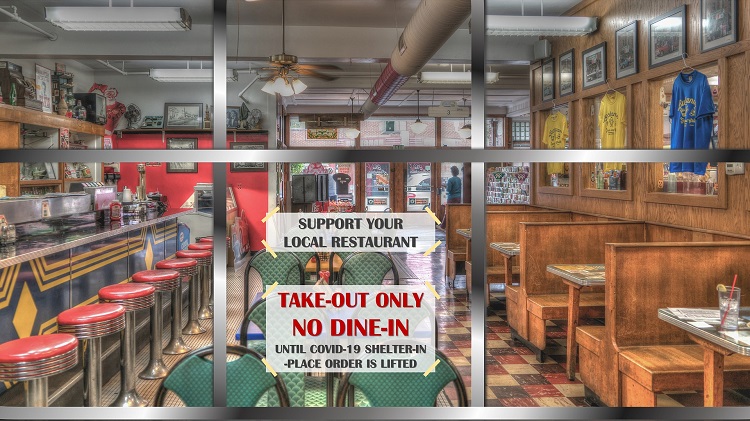Prior to the coronavirus, the Bureau of Labor Statistics reported the gap between at-home and away-from-home food expenditures had been decreasing in recent years. The global pandemic dramatically shifted the scales and now, making it to consumers’ dining table (or couch) can determine a restaurant’s success. Restaurants are balancing a host of need states ranging from consumer safety and financial concerns to a crowded restaurant landscape made up of both creative, agile independents and powerhouse chains who often have large footprints and established drive throughs. How, then, can operators better engage consumers in this new competitive landscape where home-prepared food is such a strong contender?
Communicate safety precautions
Safety is now part of consumers’ restaurant selection, with four out of five consumers indicating they will be checking to see if restaurants are enforcing safety precautions before deciding where to eat. Even more consumers think that restaurants should require guests to follow safety guidelines such as distancing or wearing masks. With consumers paying attention to the safety precautions being implemented at restaurants, boldly communicating safety practices will stand out to consumers feeling apprehensive about food away from home. Fifty-four percent of operators surveyed by Datassential already planned on adding signage to communicate sanitation methods and another 30% would consider it, indicating signage and over-communication is non-negotiable for dine-in and take-away.
Communication starts before restaurant signage though. Chains like Chick-fil-A keep patrons up to date on safety initiatives, openings and closings, and community service related to the pandemic through their own Coronavirus News page. Prior to the pandemic, this chain earned top marks for loyalty and continues to garner consumer trust for key recovery attributes like safety and sanitation. In fact, Chick-fil-A is the No. 1 limited-service chain among consumers for both trust and sanitation. According to Datassential’s COVID Recovery research, 72% of consumers agree that they trust Chick-fil-A to keep them safe, and 77% believe that they will sanitize frequently and to high standards. These communications, as well as in-store visual cues like masks, branded COVID-19 signage and prominent cleaning stations, help to reassure consumers about safety and instill trust.
Among full-service chains, Cotton Patch Cafe is the winner for trust and sanitation. Like Chick-fil-A, their corporate website includes a COVID-19 Community Update page. The stakes are even higher when it comes to dine-in, and Cotton Patch Cafe details specific precautions and rules for their staff and patrons. For example, they note: “Team members will wash their hands for 20 seconds every 30 minutes, or with a change of task (whichever comes first).” In the absence of drive-through or established delivery business among full-service restaurants, safety and sanitation tactics ensuring dining room safety take on new importance. In fact, 55% of operators say that dine in is difficult to do safely, whereas 93% say that carryout/pick-up are easy to do safely. Measures like contactless menus, removing tables to maintain six feet and established curbside pickup procedures are just a few tactics to boost consumer trust around safety and sanitation full-service chains can adopt.
Respond to consumer cravings
Even if consumers feel comfortable enough venturing outside of their home, they need a reason to go out of the way for restaurant food in the first place. Often the motivation to food away from home is a craving, or an item that restaurants do better. Just over half of consumers express a strong craving for cheeseburgers, but they are a bit more ambivalent about where they get a cheeseburger. They’re about as likely to prefer it made at home as away from home. The motivation to go to a restaurant for a cheeseburger is because of that special something. Whataburger creates that draw with a special sauce like sweet and spicy ketchup that ups the flavor ante on a classic condiment.
Some foods are just too difficult to execute at home like sushi, which is nearly as crave-able as a cheeseburger. However, over three-quarters of consumers prefer this food to be made away from home. Global foods and flavors like Chinese, Mexican and Korean BBQ will drive consumers to seek out restaurant food. These are important differentiators where the expertise of restaurants can tip the scales and win the battle for the dining room table.
If social media is any indicator COVID-19 has not slowed down consumers appetite for the latest food trends. Datassential’s own research showed that over a third of consumers (and nearly half of millennials) have found a new passion for cooking during shelter-in-place. For the foodies among us, restaurant quality food became even more attainable at home to aspiring home chefs. Family meal kits from a favorite local pizza place or fine dining meals at home from Michelin star restaurants were all in scope for creative restauranteurs as they hustled to adapt, proving that restaurants are still the place where consumers seek out food experiences.
Now more than ever consumers need a reason to venture out, so serve up tried and true menu winners your guests love and keep them coming back with fresh innovative spins they cannot make at home. Do not forget success hinges on consumer trust in this brave new world, trust in a restaurant’s ability to keep them safe and deliver on delicious food they cannot recreate at home, whether they are dining in or at home.
Related stories:
- Resilience, innovation will help the restaurant industry rebuild
- The state of sustainability during COVID-19 in the food industry
- The role of functional food and beverage in the era of COVID-19
Jamie Howe is a director at Datassential, a supplier of trends, analysis and concept testing for the food industry.
_____________________________________
If you enjoyed this article, you can sign up for Restaurant SmartBrief to get news like this in your inbox. For even more great news content, sign up for any of SmartBrief’s 275+ free email newsletters today, free.
